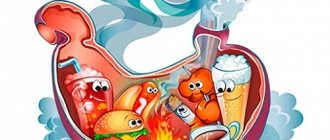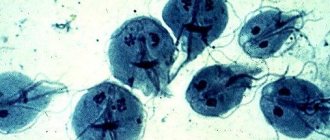What is a coprogram and why is it carried out?
It is almost impossible to make a correct diagnosis and notice the presence of a particular disease without certain tests.
Stool scatology is one of the most popular, fastest and most accessible research methods. This laboratory test is performed in almost every hospital. Feces, their physical characteristics and chemical composition can tell a lot about how the body works. In particular, by studying the results, the doctor can identify the peculiarities of the human digestive tract. In addition, testing is used in the diagnosis of diseases of the liver and gallbladder, pancreas, and stomach.
https://youtu.be/-3YcioW_-kk
Physical characteristics of feces: what do deviations indicate?
Before starting to study the chemical composition of feces, the laboratory assistant must study and enter physical characteristics into the questionnaire. They are no less important for creating a high-quality coprogram.
By the way, the patient can only note some disorders independently. For example, there are average statistical norms for the daily amount of feces. For an adult, this is 100-200 g. Naturally, we are talking about those cases when the patient follows the correct diet:
- the release of less than 100 g of excrement per day is observed with constipation of various origins;
- more than 200 g often indicates inflammation of the intestinal mucosa, accelerated evacuation of food masses, and insufficient supply of bile;
- If a person excretes more than 1 kg of excrement per day, this indicates serious pancreatic insufficiency.
Possible reasons for the violation
During normal functioning of the gastrointestinal system, starch digestion is completed in the small intestine, and the feces do not contain its residues. The following digestive tract disorders can provoke amilorrhea:
- functional pancreatic insufficiency;
- enteritis;
- fermentative dyspepsia;
- acceleration of digestion processes;
- gastritis;
- pancreatitis;
- pancreatic atrophy.
Starch in coprogram is often detected in people whose diet consists primarily of plant foods. If an infant was tested, the mother's diet could be affected. Drugs containing this complex carbohydrate also affect the analysis.
When extracellular starch is detected in feces, the cause is sought in a violation of amylase production - this indicates problems with gastric secretion. Enzymes are produced by the pancreas and problems should be looked for in this organ.
Starch is a complex carbohydrate that enters the body mainly with plant foods. Its breakdown begins already in the oral cavity at the time of chewing food, under the influence of the amylase enzyme contained in saliva. Further digestion of starch continues in the small intestine, where amylase from pancreatic juice acts on it. Ultimately, starch is broken down into simple sugars, which enter the blood.
Normally, stool should not contain starch, however, its appearance does not always indicate a disease
The reasons for the appearance of starch in stool in children and adults can be:
- significant consumption of starch-rich foods;
- diarrhea (in this case, starch does not have time to break down into glucose due to the too rapid movement of chyme through the intestines);
- acute or chronic enteritis;
- acute or chronic pancreatitis;
- pancreatic atrophy;
- fermentative dyspepsia.
Vegetables and fruits contain starch inside their cells. When chewed and in the stomach, under the influence of gastric juice, the cell membranes are destroyed, which promotes the release of starch grains to the outside.
The detection of extracellular starch in the stool indicates amylase deficiency or too rapid movement of the bolus of food through the intestines. The presence of intracellular starch in the feces of an adult or child indicates possible pathologies of the stomach, which are accompanied by a decrease in its secretory function.
Starch in a child’s stool: what does it mean, causes, treatment methods
The breakdown of complex saccharides begins in the oral cavity under the action of the enzyme amylase, produced by the gastrointestinal tract.
Catalytic processes continue inside the intestine, complex sugar is broken down into glucose, which passes through the wall of the small intestine into the blood. In a healthy body, complex carbohydrates are not present in stool.
They are found in diseases of the digestive system. The etiology of the appearance of starch in human feces:
- reduced amount of amylase;
- inflammation of the intestinal wall, accompanied by the movement of masses digested by the stomach without absorption;
- pathology of the digestive function of the intestine caused by a violation of the process of starch absorption (fermentative dyspepsia);
- disturbance of digestion in the stomach caused by an inflammatory process (gastritis, ulcer) or a reduced amount of gastric juice;
- inflammation, necrosis, atrophy of the pancreas;
- physiological reasons: underdevelopment of the secretory functions of the glands, accompanied by a decrease in the production of enzymes (in children under one year);
- plant-based diet in adults;
- detection in infants after the mother feeds plant foods;
- taking medications with complex carbohydrates or medications that inhibit the absorption of substances.
Important! Amilorrhea, which develops against the background of decreased absorption of starch in children under one year of age, does not require treatment. This is a physiological condition that goes away after the child is 3 years old.
- activity of digestive system enzymes;
- excretory function of the stomach and intestines;
- activity of intestinal microflora;
- the presence of inflammation of the gastrointestinal tract;
- the presence of parasites (worm eggs, protozoa).
To diagnose the presence of starch in a child’s stool, it is collected immediately after defecation, using clean dishes specially designed for analysis.
Attention! Collecting material using available jars or matchboxes is prohibited. They are not sterile and contain foreign microorganisms.
Clinical laboratory diagnostic doctors look at the external condition and microscopic parameters of the material. Starch in a child’s stool is detected after microscopy of a smear.
In children under 2 years of age, the presence of 2-3 units of polysaccharides detected through a microscope is considered normal.
If there is a lot of starch in the child’s stool, a full screening is performed to determine the type of polysaccharides.
A few days before testing stool for starch, you need to adhere to a protein-free diet (reduce the amount of meat, dairy products), remove potatoes and foods that change the color of urine and stool (beets) from the diet. If a stool test is taken from a breastfed baby, the mother changes the diet.
If starch appears in a stool test, the child is referred to a gastroenterologist.
If gastrointestinal dysfunction is suspected, the doctor prescribes a stool test, since amilorrhea cannot be suspected by the appearance of the child. With the help of stool analysis, the diagnosis will not only be confirmed, but also treatment will be selected. When conducting tests, the following indicators are taken into account:
- amount of material (depending on the age and weight of the person);
- shape (normally cylindrical);
- consistency (with sufficient water consumption it is soft);
- Brown color);
- specific smell;
- leftover food;
- secretions that are absent in healthy people (red blood cells, pus);
- parasites and their eggs.
Chemical studies are carried out to determine the acidity (ph) of feces and breakdown products that should be absent (red blood cells, proteins, bilirubin).
In healthy children, stool acidity (ph) varies from slightly alkaline to slightly acidic. For an accurate result of stool coprogram, stool is examined under a microscope.
It detects the presence of complex saccharides, which look like grains under a microscope.
- Intracellular starch is covered with a membrane that is broken down by enzymes. Completely digestible. The presence of this type indicates impaired intestinal function and decreased peristalsis. The carbohydrate is evacuated without having time to be absorbed.
- Extracellular starch - found when there is a lack of amylase in parts of the digestive system, insufficient production of gastric juice.
Based on the obtained stool coprogram, the attending physician will select therapy based on the collected medical history. It takes into account the patient's age.
Important! When transferring the collected material, the patient’s age is signed; the presence of a small amount of complex carbohydrates (starch) in children under 2 years of age is the norm.
Treatment of amilorrhea
If a small amount of starch grains is detected in the baby's stool, his nutrition is corrected. If the baby is breastfed, the mother's diet is changed; the quality composition of the mother's milk depends on her nutrition during breastfeeding.
Treatment of amilorrhea in children with polysaccharides in the stool and concomitant nutritional disorders is carried out by a gastroenterologist. Treatment depends on the etiological indicators.
- In case of malnutrition, a diet containing foods without the presence of starch is prescribed.
- In case of disruption of the child's pancreas, enzymes are prescribed.
- Dysbacteriosis is treated with drugs that improve the condition of the intestinal microflora.
- In case of inflammation of the gastrointestinal tract, a complete screening is carried out.
To reduce the amount of starch in a child’s stool, exclude grains, cauliflower, legumes, baked goods, nuts, potatoes, pasta, and other foods rich in starch from the diet. Additionally, carrots, pumpkin, beets, zucchini, eggplants, strawberries, melon, and apples are excluded. There the amount of polysaccharides is smaller, but in case of serious pathology they should be abandoned.
Products containing protein are allowed for consumption: meat, dairy products, eggs. Vegetables eaten include tomatoes and cucumbers.
When selecting medications, take into account the child’s age, weight and identified pathology of digestive function. Pediatricians and gastroenterologists recommend the following drug groups for the treatment of amilorrhea in children:
- preparations containing gastrointestinal enzymes (Pancreatin, Creon, Mezim);
- non-addictive laxatives (Duphalac);
- probiotics (Linex, Normobact-L);
- anti-diarrhea medications (Smecta).
The doctor can prescribe the drug, determining the duration of its course individually, depending on the test results. When using medications, you cannot independently adjust the dosage of the drug.
If amilorrhea is detected in children, self-medication is excluded. Mom can seriously harm the digestive tract by choosing the wrong drug or its dosage. After therapy with a gastroenterologist and following a diet, the prognosis for the disease is favorable.
Starch is a complex chemical compound that enters the body mainly from plant foods. Starch in a child’s feces is observed when the gastrointestinal tract organs malfunction, due to which the breakdown processes worsen. A large number of grains of this substance in human waste products is called amilorrhea.
Starch in feces
The first stage of starch breakdown occurs in the human mouth. Our saliva contains the enzyme amylase, which begins the digestion process. The breakdown process then continues in the intestines. This complex carbohydrate breaks down into glucose upon contact with a pancreatic enzyme.
Starch is completely absorbed by the body in the presence of a sufficient amount of amylase and pancreatic secretions. In a child under 1 year of age, the detection of starch grains is not always associated with the disease. In infants, this may occur due to incomplete functional maturation of the internal glands that produce enzymes.
In infants, amilorrhea is considered normal. Most often, the pathology does not require therapy, since it disappears on its own after some time. Amilorrhea is diagnosed by conducting a special laboratory test called a coprogram. As a result of the study, the physical and chemical properties of the biomaterial are analyzed.
- Intracellular starch. It is contained in the inner membranes of plant cells. With the normal functioning of the gastrointestinal tract, this type of carbohydrate is completely digested. Due to the accelerated passage of undigested food through the intestines, enzymes may not have time to decompose the complex substance, which leads to the detection of traces of it in the child’s biomaterial.
- Extracellular starch. These are undigested grains from destroyed plant cells. The coprogram of a healthy person will not detect this substance in the biomaterial.
After additional tests, the main causes of amilorrhea are discovered. This pathology can be caused by:
- amylase deficiency in saliva;
- a small amount of gastric juice secreted;
- insufficiency of enzymatic activity of the pancreas.
A lot of starch in a child’s stool may indicate the development of pathologies. Such diseases include:
- Enteritis is a disease of the small intestine and its peristalsis. Due to the development of pathology, digested food begins to move extremely quickly through the digestive tract.
- Gastritis and other diseases that lead to disruption of the functioning of the stomach.
- Fermentative dyspepsia.
- Atrophy or inflammation of the pancreas.
- Impaired absorption of starch caused by intestinal dysbiosis.
The following factors may affect the results of the coprogram:
- Excessive consumption of potatoes, pears, bananas and other foods that contain starch.
- Poor nutrition.
- Living in an area with an unfavorable ecological environment.
Medicines containing starch carbohydrates are not recommended for children, which is why the reasons for poor coprogram results often lie in their use.
You should not try to treat the pathology yourself. You should immediately contact a gastroenterologist. The doctor will prescribe special tests.
The coprogram will help you understand in detail the root causes of malfunctions in the functioning of the child’s gastrointestinal tract.
To treat amilorrhea, you need to change your diet; first, it is recommended to limit the consumption of fruits and vegetables that contain the substance. In most cases, drug treatment with drugs that restore intestinal microflora cannot be avoided.
Main indicators of stool analysis
Complex carbohydrates are broken down into glucose under the action of enzymes from pancreatic juice and saliva. In this form, starch absorption occurs completely. It is difficult for a fragile child's body, which is at the stage of formation, to cope with this process. Double the content of the substance is the norm for infants. But if the child is older than 2-3 years, amilorrhea is diagnosed.
Based on the results of the study of feces, laboratory assistants compose a sample questionnaire. The “correct” analyzes have certain characteristics:
- the masses are dense and brown, without blood, food breasts and inclusions of mucus;
- there is no excessively pungent foul odor;
- neutral pH reaction;
- there are no starch grains, bilirubin, proteins and leukocytes;
- Possibly moderate amount of muscle fibers.
If starch is detected in the coprogram, the adult may need additional research to determine the type of carbohydrate. The feces passed by the child are assessed according to the same scheme, but a small amount of grains is considered a physiological norm.
To maximize the effectiveness of the analysis, simple preparation is necessary. A few days before stool collection, meat dishes, tomatoes, beets and potatoes are excluded from the diet. If an infant is being tested, the mother must follow the diet. If you are taking medications, you should inform your doctor in advance: they may contain starch, which will lead to inaccurate results.
There are not many diseases of internal organs for which differential diagnosis does not require obtaining a coprogram. The doctor may order an examination to check whether starch is present in the stool, whether there are traces of helminthic infestations, proteins or occult blood, etc. A natural question is whether the examination requires any specific preparation. Some rules will help you get accurate information:
- It is recommended that you eat a basic, healthy diet for a few days before collecting samples. You should exclude colored vegetables, fish, fatty meats and, of course, foods with food dyes from your diet.
- If you are taking any medications without the ability to stop therapy for a few days, be sure to tell your doctor.
- The collection should not be carried out on women during menstruation - it is better to wait until it ends.
- If bowel movements are a problem (for example, constipation), you should not use laxatives or enemas, as this may distort test results. It is better to wait for natural bowel movements.
basic information
Starch is a substance that is often found in food (plant foods). This is a complex carbohydrate, which, when present in a growing plant, protects it from low temperatures and activates the development of plant fibers in the spring.
The following products contain starch:
- rice porrige,
- oatmeal,
- corn,
- wheat,
- potato,
- peas,
- beans,
- kvass,
- Rye bread.
When eating food, this polysaccharide begins to break down in the oral cavity, with the help of enzymes contained in saliva. In the stomach it is broken down by gastric juice. After these processes, starch is converted into glucose and is completely absorbed by the body. This applies to both adults and children.
If starch was found in large quantities in the child’s coprogram, then you are dealing with the disease Amilorrhea. Sometimes, the appearance of such a problem is caused by heavy complementary foods that were introduced into the baby’s diet too early, with diseases of the gastrointestinal tract.
Diagnosis of amilorrhea
The presence of undigested starch grains in stool is detected during a general stool analysis. In a normal coprogram, starch, as well as leukocytes, red blood cells, proteins, bilirubin and mucus, should be absent.
Amilorrhea is not an independent disease. Its appearance can be caused by many factors. For example, the presence of undigested starch in children of the first years of life (1-2 years) is explained by the physiological immaturity of their digestive system, therefore, in this case, amilorrhea is not a pathology.
If older children and adults eat too many vegetables and fruits, as well as other foods rich in starch (jelly, baked goods, cereals), they also often have undigested starch grains in their stool. And in this case, this is not immediately considered as an unambiguous sign of pathology.
- repeat general stool analysis;
- bacteriological examination of stool;
- stool examination for dysbacteriosis;
- ultrasound examination of the pancreas, liver and gallbladder;
- FEGDS (fibroesophagogastroduodenoscopy);
- determination of gastric juice acidity.
When collecting stool for testing for starch content (as part of a coprogram), it is important to follow the rules for preparing, collecting and storing the material. Their violation can cause false results, as a result of which the correct diagnosis of diseases of the digestive system is difficult and the prescription of appropriate treatment is delayed.
How to donate stool?
Test results largely depend on proper sample preparation and collection. So how to donate feces? There is nothing complicated in the procedure. To collect samples, it is recommended to purchase a special plastic container with a lid. Such containers are sold in almost any pharmacy. They are equipped with a convenient spatula for collecting feces.
Before the procedure, you should wash, otherwise during the study, uncharacteristic bacterial organisms, epithelial cells, and chemical compounds may be detected, which, naturally, will affect the further diagnostic process. The collection is carried out immediately after defecation.
According to laboratory technicians, a complete analysis requires one teaspoon of material. Smaller samples may not be sufficient to perform all tests. Feces should be sent to the laboratory as quickly as possible - no later than 5-7 hours after collection. The longer the biomaterial is stored, the less likely it is to obtain accurate results, because under the influence of environmental factors (light, temperature, air) some chemical components of feces are destroyed, which leads to distortion of information. It is best to store the sample container in the refrigerator.
If a coprogram is carried out on a baby, then parents are not recommended to collect feces from the diaper - it is better to first place a clean diaper under the baby. If a special plastic container is not available, samples can be placed in a glass jar, but it must first be sterilized.
Treatment of amilorrhea
Since in children of the first years of life the presence of starch grains in the stool is a variant of the norm, no treatment is prescribed for them.
If amilorrhea is caused by an excess of carbohydrate foods, then the patient is prescribed a therapeutic diet. Products with a high starch content are excluded from the menu:
- legumes;
- cereals;
- nuts;
- pasta;
- potato;
- all types of baked goods;
- jelly.
In addition, it is necessary to limit the consumption of the following vegetables: carrots, beets, pumpkin, zucchini, eggplant, cauliflower, apples, melon, strawberries.
The recommended diet includes milk and dairy products, eggs, cucumbers, tomatoes, white cabbage and lean meat.
It should be taken into account that some unscrupulous manufacturers use starch as a thickener in the production of dairy products (yogurt, sour cream, ice cream). Therefore, if a child or adult is diagnosed with a severe malabsorption of starch, then it is better to refuse to purchase these products in stores and prepare them yourself.
Amylorhea may be caused by a diet containing large amounts of starchy foods.
Drug treatment is prescribed only when amilorrhea develops against the background of pathology of the digestive system. Therapy is aimed at treating the underlying disease that caused insufficient absorption of starch. Depending on the indications, the patient is prescribed drugs of the following groups:
- enzyme agents;
- eubiotics, pro- and prebiotics;
- Acidin-pepsin;
- antidiarrheals;
- anthelmintic drugs;
- bacteriophages.
In addition to drug treatment, diet therapy is indicated.
Main indicators of stool analysis
After the necessary tests have been carried out, a special questionnaire is drawn up. There are many different physical and chemical characteristics that scatology takes into account. Decoding and interpreting the data obtained is the doctor’s task. However, you can see what the ideal results should look like:
- feces of brown color and dense consistency, without inclusions of mucus, food breasts and blood, without an excessively fetid or pungent odor;
- Normally, the water content in feces is 80%;
- the pH reaction must be neutral;
- leukocytes, bilirubin, proteins and starch should be absent in the stool analysis;
- A small amount of muscle fiber is allowed.
Naturally, the amount of data in the questionnaire may vary depending on the doctor’s instructions. For example, if you need to test feces for carbohydrates, then the laboratory assistant carries out reactions not only for the presence of starch, but also for its type. The same applies to tests for occult blood.
Associated symptoms
There are no specific clinical signs of amilorrhea. The patient can pay attention to the well-known symptoms of ill health of the digestive canal, namely:
- bloating, passing gas;
- feeling of discomfort, diffuse diffuse pain of moderate intensity;
- rarely nausea and vomiting;
- several (2-3) acts of bowel movement per day;
- abundant feces with an unpleasant fetid odor, areas of undigested food are visually visible;
- with long-term pathology - loss of body weight due to poor absorption of nutrients.
If any of the above signs appear once, then there is no need to worry. If such symptoms appear regularly or persist over a long period of time, the help of a specialist is necessary.
Coprology: decoding and normal indicators
Before starting to study the chemical composition of feces, the laboratory assistant must study and enter physical characteristics into the questionnaire. They are no less important for creating a high-quality coprogram.
By the way, the patient can only note some disorders independently. For example, there are average statistical norms for the daily amount of feces. For an adult, this is 100-200 g. Naturally, we are talking about those cases when the patient follows the correct diet:
- the release of less than 100 g of excrement per day is observed with constipation of various origins;
- more than 200 g often indicates inflammation of the intestinal mucosa, accelerated evacuation of food masses, and insufficient supply of bile;
- If a person excretes more than 1 kg of excrement per day, this indicates serious pancreatic insufficiency.
Another important factor is consistency. Feces are 80% water. With diarrhea, this figure increases to 95%, but constipation is accompanied by a decrease in the amount of fluid to 70-65%. Normally, the stool of an adult is formed and has a dense consistency. What the analysis can tell you:
- abundant semi-liquid feces with oily impurities may indicate impaired absorption of fat in the intestines;
- pasty stool appears when there is insufficient amount of bile and secretion disorders in the pancreas;
- loose, mushy excrement indicates increased fermentation processes, colitis, enteritis;
- liquid feces appear when digestive processes in the small intestine are disrupted;
- solid feces of a ribbon or spiral shape are observed with constipation, hemorrhoids, as well as with the formation of tumors in the colon;
- semi-liquid, foamy feces are characteristic of fermentative colitis and irritable bowel syndrome.
An important factor for diagnosis is the color of the stool:
- light brown stool indicates accelerated evacuation of intestinal contents;
- reddish feces are observed with inflammation and ulceration of the mucous membrane of the colon;
- with disorders of motility and digestion in the small intestine, patients often note that the stool becomes yellow;
- white stool may indicate blockage of the bile ducts;
- With diseases of the pancreas, stool may acquire a gray or yellow-gray tint.
As for other signs, they also pay attention to the smell. Naturally, it depends primarily on food and the amount of protein foods consumed. This is a subjective factor, although it should not be ignored. For example, the presence of a sour odor may indicate fermentative dyspepsia.
It is worth understanding that physical characteristics directly depend on nutrition. That is why, a few days before the test, it is recommended to switch to simple, healthy foods. Overeating, a strict diet, the use of dyes and preservatives - all this can distort the results.
After studying the physical parameters, the laboratory assistant proceeds to study the chemical composition of feces. So, what should not be present in human excrement and what pathologies can be detected using this analysis?
- A bad sign is the presence of protein in stool samples. Its presence may indicate enteritis, dysbacteriosis, ulcerative lesions of the digestive tract, gastritis, cancer, rectal fissures and hemorrhoidal formations.
- Hemoglobin is a component of red blood cells that is absent in healthy human stool. The test for occult blood is positive for ulcers, bleeding in any part of the digestive tract (including the oral cavity), the formation of polyps and hemorrhoids, and hemorrhagic diathesis.
- Stercobilin is a substance that is formed during the breakdown of hemoglobin molecules. A decrease in its amount indicates pancreatitis, hepatitis, cholangitis, and liver damage. But its increased content in feces is observed in hemolytic anemia.
- Bilirubin is found in the stool of an adult in severe forms of dysbiosis, as well as increased intestinal motility. By the way, this element may be present in children in the first year of life.
- The presence of leukocytes indicates an inflammatory process, in particular ulcerative colitis, dysentery, cancer, and tuberculosis of the large intestine.
- The presence of mucous impurities in the stool sometimes indicates the presence of an infection in the intestines.
- If the stool contains a large number of muscle fibers, this may also indicate a number of pathologies, including dyspepsia, constipation, ulcerative colitis, impaired bile flow, and failure of the digestive processes.
- Digestive disorders in the small intestine, insufficient supply of bile, putrefactive and fermentative dyspepsia are accompanied by the release of fatty acids along with feces.
In addition, stool analysis helps diagnose parasitic diseases. Feces may contain eggs, larvae or segments of helminths, as well as Giardia, dysenteric amoebas and other pathogenic microorganisms.
Norm and deviations
Normally, in children under 2-3 years of age, 2-3 units of polysaccharides may be present in the feces, which are detected through a microscope.
Loose stools in a breastfed baby
If starchy grains are found in the baby, then this is interpreted differently. If the patient is a child under 1-3 years old, then if there is a small amount of indigestible fiber present, this is normal. In children, digestive structures are just forming; gastrointestinal enzymes are not sufficiently developed.
Note! If a baby is constantly anxious and has frequent abdominal pain, this may indicate a disorder in the gastrointestinal tract. Tests are prescribed, one of which is a coprogram. After stool, the material is collected in sterile jars, and not in improvised means or matchboxes.
In children over 3 years of age, starch may increase for the same reasons as in adults.
Stool pH reaction
Separately, it is worth highlighting such a parameter as pH. The reaction of feces should be neutral - its values range from 6.8-7.6. If the test data does not correspond to the norm, then the following violations are possible:
- a slightly alkaline reaction occurs against the background of disturbances in the digestive processes in the small intestine;
- an alkaline reaction may indicate diseases of the pancreas, digestive disorders in the stomach, increased secretory activity in the large intestine, ulcerative colitis;
- a sharply alkaline reaction, as a rule, is observed with putrefactive dyspeptic symptoms;
- a pronounced acidic environment, on the contrary, indicates dyspepsia associated with intense fermentation processes in the intestines;
- a moderately acidic environment is associated with impaired absorption of fatty acids.
By the way, a child’s feces can give an acidic reaction, especially if the newborn is bottle-fed - this is due to the composition of the milk formula, so there is no need to worry in advance. Additional information is needed to make an accurate diagnosis.











